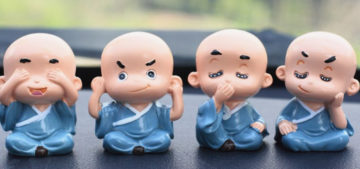by Deanna K. Kreisel (Doctor Waffle)
 I have a confession to make: I ❤️ Seymour Glass. If you don’t know who that is, count yourself lucky and walk away now—come back in a few weeks when I’ll be discussing humiliating experiences at middle-school dances or whatever. (Obviously I am joking—as always, I desperately want you to finish reading this essay.)
I have a confession to make: I ❤️ Seymour Glass. If you don’t know who that is, count yourself lucky and walk away now—come back in a few weeks when I’ll be discussing humiliating experiences at middle-school dances or whatever. (Obviously I am joking—as always, I desperately want you to finish reading this essay.)
For the uninitiated, Seymour was the scion of the Glass family, a half-Jewish-half-Irish troupe of tragic prodigies populating nine stories by J. D. Salinger, of Catcher in the Rye fame, set in the years 1924 to 1959. If you’re familiar with the oeuvre of Wes Anderson, you probably know that the Royal Tenenbaums are generally considered an homage to the Glasses. Both families are casually and eccentrically well-to-do, aswim in a world of brownstones, 5 p.m. martinis, private education, summers in the Hamptons, family branches in Connecticut, fur coats, and tennis lessons. And they’re all brilliant. On this point Salinger was most adamant—every child of the Glass family, all seven of them, appeared on the fictional radio program “It’s A Wise Child,” a purportedly wholesome entertainment wherein smarty-pants kids are prompted to say unintentionally hilarious smarty-pants things, but (IMO) is clearly just a wisecrack sweatshop where children are ruthlessly exploited for their youthful naïveté and left dessicated husks sucked dry of all joy.[1]
But Seymour alone is a true savant. Precocious even by Glass family standards, he is a brilliant poet who becomes a professor of English at Columbia by the age of 20. He is also the most tragic member of the gang, a real Romantic-hero type. Too smart and sensitive for the world around him, even his gifted family members,[2] he eventually blows his brains out in a Florida hotel room in front of his sleeping wife. This all happens in the very first story in which he appears, “A Perfect Day for Bananafish,” so from the moment of his introduction we already know he is doomed. Read more »

 Now that the hangover from New Year’s Eve is abating for many, and we might be freshly open to some self-improvement, consider a Buddhist view of using meditation to tackle addictions. I don’t just mean for substance abuse, but also for that incessant drive to check social media just once more before starting our day or before we finally lull ourselves to sleep by the light of our devices, or the drive to buy the store out of chocolates at boxing day sales. Not that there’s anything wrong with that on its own– it’s a sale after all–but when actions are compulsive instead of intentional, then this can be a different way of approaching the problem from the typical route. I’m not a mental health professional, but this is something I’ve finally tried with earnest and found helpful, but it took a very different understanding of it all to get just this far (which is still pretty far from where I’d like to be).
Now that the hangover from New Year’s Eve is abating for many, and we might be freshly open to some self-improvement, consider a Buddhist view of using meditation to tackle addictions. I don’t just mean for substance abuse, but also for that incessant drive to check social media just once more before starting our day or before we finally lull ourselves to sleep by the light of our devices, or the drive to buy the store out of chocolates at boxing day sales. Not that there’s anything wrong with that on its own– it’s a sale after all–but when actions are compulsive instead of intentional, then this can be a different way of approaching the problem from the typical route. I’m not a mental health professional, but this is something I’ve finally tried with earnest and found helpful, but it took a very different understanding of it all to get just this far (which is still pretty far from where I’d like to be).